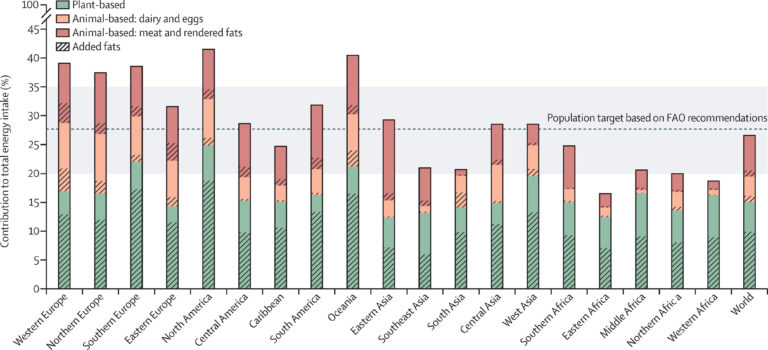The average consumption of fats in many populous regions of the world is below nutritional recommendations. But how do we increase fat production sustainably, when so much of the fat traces back to livestock sources and deforestation?
There is a consensus that high-income countries need to reduce the consumption of animal-based products due to their high environmental footprint. Researchers and policymakers have focused on protein as the critical nutrient that will need to be managed carefully through that transition.
However adequate fat consumption is also critical for health, and like protein (in fact even more so), in large parts comes from animal products. This month we published a study in Lancet Planetary Health that examined global patterns of fat consumption in the context of sustainability and health. Is there a need to increase or decrease fat production? And what are the best strategies for doing so?
The study shows that fat consumption is below the recommended level in many large densely populated regions in the world. This has a negative impact on the population’s nutritional status, and contributes to an insufficient calorie supply and nutritional deficiency in fat-soluble vitamins and essential fatty acids. On the other hand, some regions consume more fat than current global recommendations advocate, although it is unclear whether this has any negative health effects.

According to our calculations, an additional 45 million tonnes of dietary fat is needed for regions with a fat deficit to be able to reach the recommended target. The increase in population will mean that the gap between demand and current production will be significantly larger in 2050 (approximately 110 million tonnes for middle population projections) and even larger if we strive for the higher fat consumption advocated by e.g. the Nordic Nutrition Recommendations or the EATLancet Planetary diet.
To fill this gap we have several options. Increasing animal-based fats such as pork and dairy (currently globally the two biggest sources of fat) is not desired due to the high environmental footprint. Of animal-based products, we could increase the consumption of lard and tallow, as currently, due to consumer preferences, much that could be eaten goes to non-food uses or even waste despite some evidence of having some health advantages over other animal fats such as butter.
However, increasing the production of plant-based fats also poses challenges. The production of soybean and palm oil has e.g. historically caused deforestation.
Strong protection of the remaining rainforest is critical. If that could be achieved, then using palm oil would not be so contentious, as it otherwise has low land and water footprint. Furthermore, its production could be increased through yield increases in existing plantations, where there seems to be a lot of potential.
In temperate climates, rapeseed oil seems to be the strongest candidate for the supply of healthy fats. However, rapeseed should not be grown more frequently than every five to seven years in a crop rotation to prevent disease and pest infestation, which limits the amount of rapeseed oil that can be produced on suitable land.
The biggest potential to increase dietary fat supply is to utilise the large amounts of edible oils that are used for non-food purposes.
Unfortunately, it is difficult to even estimate how much of these oils are for non-food purposes. We found large variations in the statistics available. According to the US Department of Agriculture (USDA), this is 50 million tonnes, while according to the United Nations Food and Agriculture Organization (FAO) it is 90 million tonnes. This highlights how little attention is paid to this topic so far.
Microbial oils are also an interesting future fat source. Some microorganisms can accumulate large amounts of oil – up to 70 percent of the biomass – and they have a fatty acid composition similar to that of vegetable oils. The conversion of residual products such as straw, wood chips and sawdust into valuable oil with the help of fat-storing yeasts is tested at SLU. However, the cost of production and consumer acceptance will be of importance.
Bojana Bajželj, Federica Laguzzi & Elin Röös. 2021. The role of fats in the transition to sustainable diets. Lancet Planet Health. https://doi.org/10.1016/S2542-5196(21)00194-7
